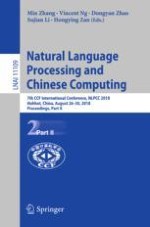2018 | Buch
Natural Language Processing and Chinese Computing
7th CCF International Conference, NLPCC 2018, Hohhot, China, August 26–30, 2018, Proceedings, Part II
herausgegeben von: Min Zhang, Vincent Ng, Prof. Dongyan Zhao, Sujian Li, Prof. Dr. Hongying Zan
Verlag: Springer International Publishing
Buchreihe : Lecture Notes in Computer Science
